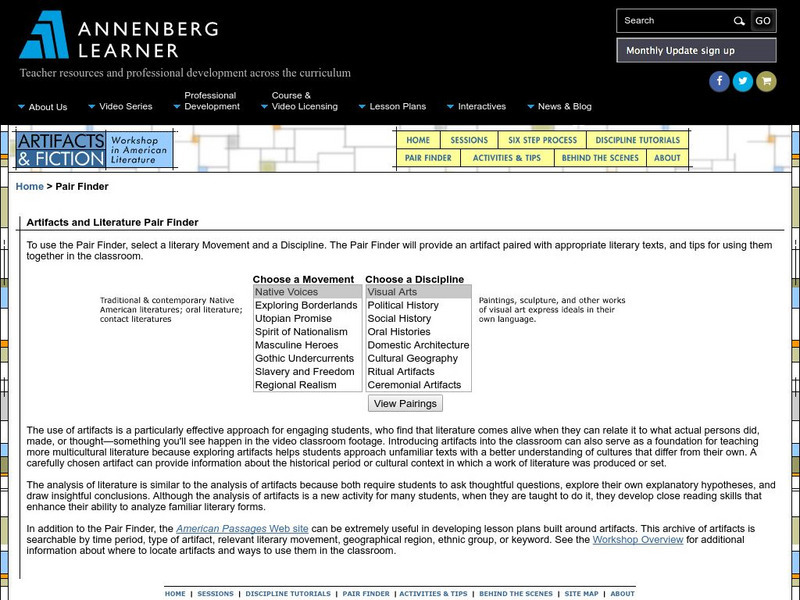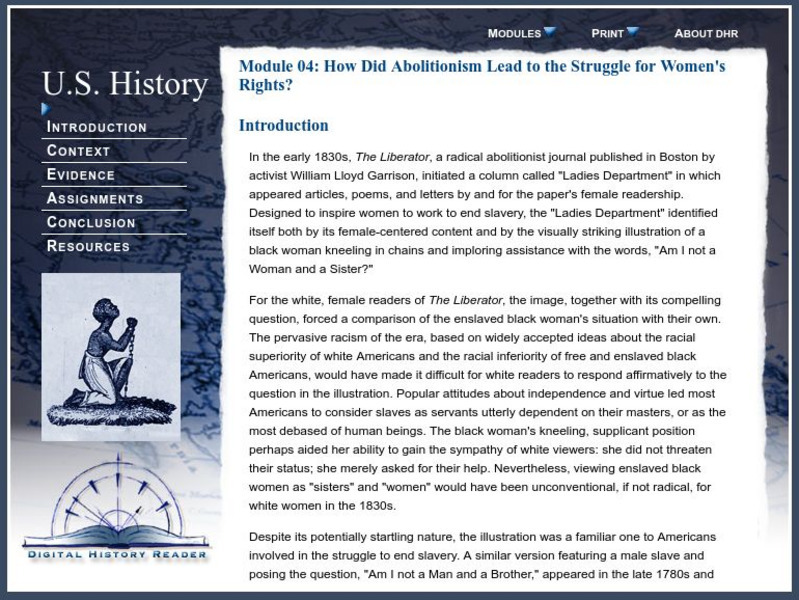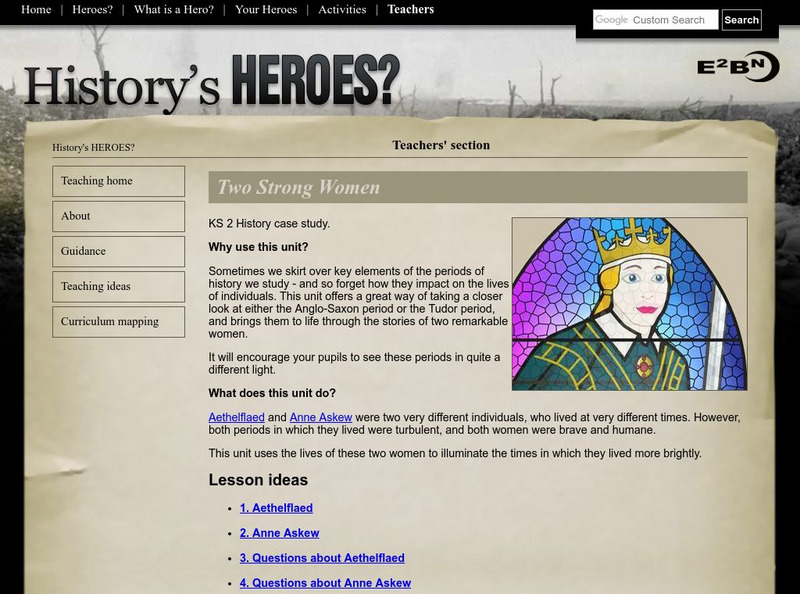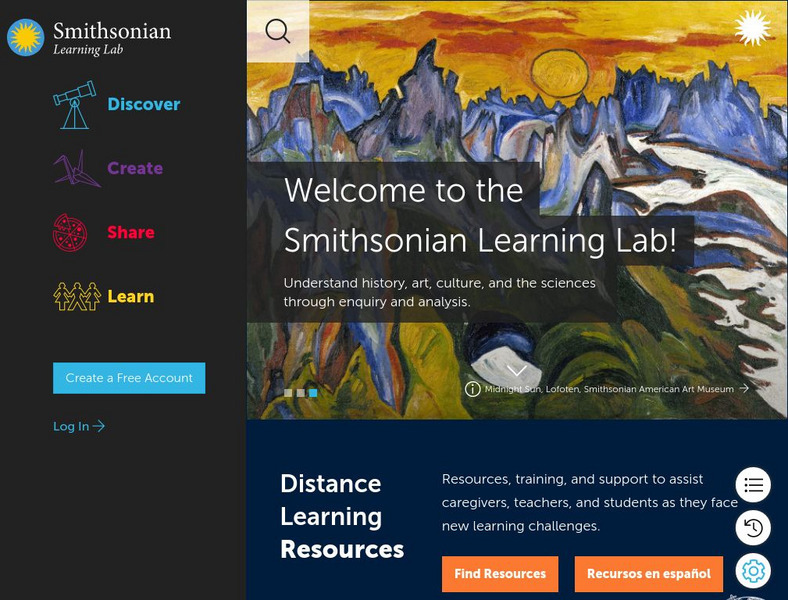Annenberg Foundation
Annenberg Learner: Bridging World History: History and Memory
Are history and memory different? Peruse the various resources this unit provides for the way we view, know, and relate history to our family, our friends, and the world.
Stanford University
Stanford History Education Group: Home
[Free Registration/Login Required] Working with school districts from coast to coast, and as far away as Sweden, Singapore, and Chile, the Stanford History Education Group provides teachers with high-quality resources to enrich students'...
Sophia Learning
Sophia: Research Sources
This slideshow lesson focuses on research sources by listing 10 types of sources: books, periodicals/magazines, newspaper articles, scholarly articles, databases, reviews, interviews, lectures, media (film, television), and websites. It...
Sophia Learning
Sophia: Research Sources: Periodicals
This slideshow lesson focuses on the use of periodicals as research sources; it discusses the pros of using periodicals as organizational aids and in research of current events and also the cons of periodical's lack of depth and possible...
Annenberg Foundation
Annenberg Learner: Artifacts & Fiction Pair Finder
Pair artifacts with appropriate literary texts, and find tips for using them together in the classroom by selecting a literary movement and a discipline with this handy tool.
Annenberg Foundation
Annenberg Learner: America's History in the Making: Historical Thinking Interactives
Six interactive activities are presented that walk students through how to use their critical thinking skills in the analysis of historical artifacts and documents. The sixth one explains how to balance the various perspectives that...
Houghton Mifflin Harcourt
Holt, Rinehart and Winston: Writer's Model: Historical Research Paper
This eleven-page research paper provides an example of a historical research project. Clicking on the "Writer's Guide" link in the upper right-hand corner of the page enables the user to get tips, directions, and explanations on the essay.
Georgia Department of Education
Ga Virtual Learning: Nonfiction and Reseach: "Choosing Nonfiction Sources" [Pdf]
This is the 20-page PDF "Choosing Nonfiction Sources." It provides informatation about various types of nonfiction: primary and secondary sources, reference works, databases, newspapers and periodicals, and nonfiction books; it also...
Annenberg Foundation
Annenberg Learner: Interactives: Historical and Cultural Contexts
This interesting interactive website explains kinds of primary sources and gives you the chance to identify them in some games.
Other
Babson College: Evaluating Quality on the Net
Internet research is a fine writing tool, but can you trust the information you find? This presentation by Hope N. Tillman, Director of Libraries at Babson College, gives advice on assessing the quality and credibility of information...
Virginia Tech
Dhr: How Did Abolitionism Lead to the Struggle for Women's Rights?
Online learning experience consists of a self-contained module focussing on abolitionism and the struggle for women's rights. The module includes an introduction outlining the module objectives and historical questions, background...
Virginia Tech
Digital History Reader: Introduction
An online learning module for the U.S. and European history. Presents central questions of key events in history. Students explore data, evaluate conflicting accounts or interpretations, and develop conclusions based on primary evidence....
Center for Innovation in Engineering and Science Education, Stevens Institute of Technology
Ciese: Historical Treasure Chests
After learning to distinguish between primary and secondary sources, young scholars will examine four primary documents and address a set of questions for each.
University of California
University of California, Davis: The History Project
The History Project is a growing collection of lesson plans, teaching tools, digitized images, and documents for the teaching of history. Includes assignments for having students apply analytical skills to primary sources.
American Rhetoric
American Rhetoric: Communication Journals
This is an index of communication journals and their publishers with links to the journals.
East of England Broadband Network
E2 Bn: History's Heroes: Two Strong Women
This unit features Aethelflaed and Anne Askew, two women from two different periods of England's history, who demonstrated great strength and fortitude in their respective eras. Identify similarities and differences of the women and...
Stanford University
Stanford U.: Evaluating Information: The Cornerstone of Civic Online Reasoning
This report from the Stanford History Education Group describes the conclusions of their work in field testing a set of assessments of civic online reasoning by young people from the middle school to the college level. Middle school...
Texas Education Agency
Texas Gateway: Determining Validity and Reliability of Sources
This lesson will help students decide which sources are valid and reliable for supporting a thesis. It discusses how to evaluate books, articles, websites, and more.
Texas Education Agency
Texas Gateway: Gathering Appropriate Information (English Iii Writing)
[Accessible by TX Educators. Free Registration/Login Required] This lesson focuses on finding and evaluating relevant sources for a research project. It includes primary and secondary sources and print and internet sources. W.11-12.2...
Texas Education Agency
Texas Gateway: Analyze the Relevance, Quality, and Credibility of Evidence
[Accessible by TX Educators. Free Registration/Login Required] In this lesson, students will learn to analyze the quality, relevance, and credibility of evidence used to support an argument.
Department of Defense
Do Dea: Discovery and Attribution
The research process can be daunting, but it doesn't have to be overwhelming! After you complete this self-guided unit, you will be well prepared to write a research paper. You will learn how to choose a topic, evaluate the reliability...
Polk Brothers Foundation Center for Urban Education at DePaul University
De Paul University: Center for Urban Education: Use Evidence to Show How a Writer Supports
This Center for Urban Education resource provides a downloadable graphic organizer for students to use when analyzing the evidence that authors use to support a claim. RI.9-10.5 ideas/claims developed. CCSS.ELA-Literacy.CCRA.R.8
Smithsonian Institution
Smithsonian Learning Lab: Teaching With Primary Sources
Five lesson plans, complete with videos, primary sources, and document-based questions (DBQ) to encourage students to utilize primary sources and incorporate thinking and writing into daily learning. Topics include: Artifact &...
Lumen Learning
Lumen: Building Credibility Through Source Integration
Well-integrated sources build credibility in several ways: Source material adds evidence and support to your argument, the signal phrase highlights the reputation and qualifications of the source, and effective citation makes it easy for...









![Ga Virtual Learning: Nonfiction and Reseach: "Choosing Nonfiction Sources" [Pdf] Unit Plan Ga Virtual Learning: Nonfiction and Reseach: "Choosing Nonfiction Sources" [Pdf] Unit Plan](https://d15y2dacu3jp90.cloudfront.net/images/attachment_defaults/resource/large/FPO-knovation.png)












